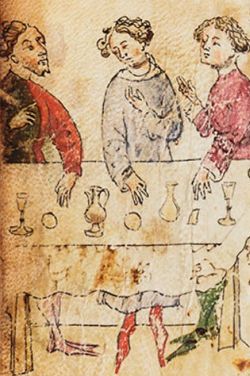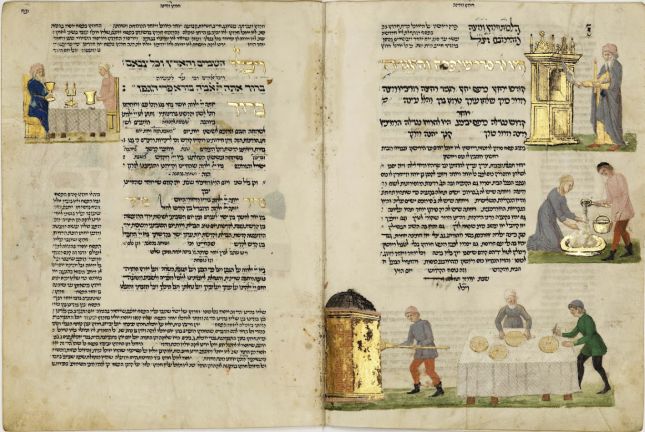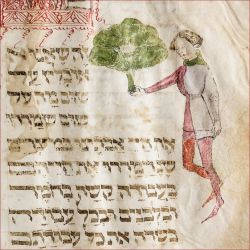At the start of this year’s Holy Week a terrible blaze engulfed Notre-Dame. As I watched the spire of the cathedral fall, I wondered how destructive smoke and flames have often been to books throughout history. Vulnerable older editions from the 16th, 15th and even 13th centuries must have survived the misfortunes brought about by poor conditions and destructions such as those caused by fires. How many old, unique manuscripts has humanity lost through the centuries because of natural or man-made disasters? The destruction of an original manuscript created before the invention of the printing press is truly an invaluable loss to humanity’s evolution.
Arguably, the most richly illuminated Hebrew manuscript from Renaissance Italy is the Rothschild Miscellany, which is housed in Jerusalem at the Israel Museum. Commissioned by Moses ben Jekuthiel ha-Kohen, the Miscellany, consists of approximately 950 beautifully ornamented and illustrated pages, embellished with three different types of gold – burnished gold, flat gold and powdered gold. It contains a collection of more than 70 books and treatises, ranging from the Biblical books of Psalms, Proverbs and Job, Halahic and Aggadic compilations, to philosophical, historical, homiletical books of the Middle Ages, and Isaac Solomon Abi Sahula’s Meshal ha-Kadmoni.
The illustrations portray biblical scenes, numerous religious practices and customs regarding prayer and life cycle events in the Jewish tradition, likely to have been the product of craftsmen trained by some of the great artists of the Italian Renaissance. The manuscript carries the name of Rothschild, because it had been in the possession of the Rothschild family from generation to generation. During World War II, it was stolen, to be later returned to the owners by Dr. Alexander Marx, librarian of the Jewish Theological Seminary of America. The Rothschild family donated the manuscript to the Bezalel National Art Museum in Jerusalem in 1957. In 1964, Bezalel was incorporated into the new Israel Museum, where the Miscellany has been housed and exhibited ever since.
The London publisher, “Facsimile Editions,” in cooperation with the Israel Museum, produced a facsimile of the Rothschild Miscellany in a limited edition of 550 copies. Every copy is bound in wooden boards, covered in Morocco goatskin with the three different types of gold, and faithfully copied by hand. The copies were quickly picked up by collectors and institutions leaving only single leaves available for sale at prices over $100 each.
Among the Grande Roue de Paris Ferris wheel, Russian nesting dolls, diesel engines, talking films, escalators, and the telegraphone, another remarkable medieval manuscript, the Lombard Haggadah, was on display at the Exposition Universelle of 1900, better known in English as the 1900 Paris Exposition. That was the last time that the manuscript was on public display, observable to the 50 million or so visitors of the expo. 119 years later, the manuscript is on private display at the Les Enluminures Gallery in New York, (RSVP required).
The Haggadah, with seventy-five watercolor paintings created in the circle of the famous artist Giovannino de’ Grassi (d. 1398), in Milan, in the late fourteenth century, commemorates the Israelites’ Exodus from Egypt, and their transition from slavery to freedom. It survives as the earliest stand-alone Italian Haggadah. The manuscript was owned by a French family who exhibited at the Exposition Universelle and later, in 1927, sold it in London to Zalman Schocken, a noted collector of Hebrew manuscripts. One of only three illustrated manuscripts, Haggadot remains in private hands, and is also for sale — for an undisclosed ‘mid to upper seven-figure sum’.
The main ritual of Passover is the Seder, the ritual feast that marks the beginning of the Jewish holiday and occurs on the first night of the holiday. The festive meal is accompanied with the re-telling of the Exodus through stories and song and the consumption of ritual foods, such as matzah and maror (bitter herbs). The Seder’s rituals and other readings are outlined in the Haggadah. Les Enluminures and its founder Dr. Sandra Hindman have organized several events to accompany the exhibition of this Haggadah, which will remain on view until 20 April. The events include a gallery talk and a conference on the subject of Haggadot in the Middle Ages. Please visit the press release for more information.



{ 0 comments… add one now }